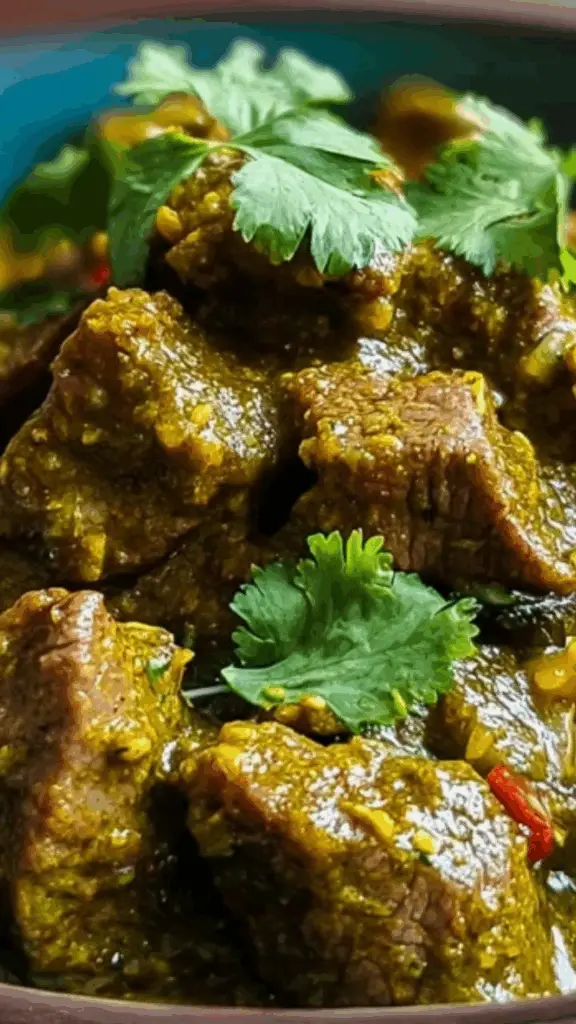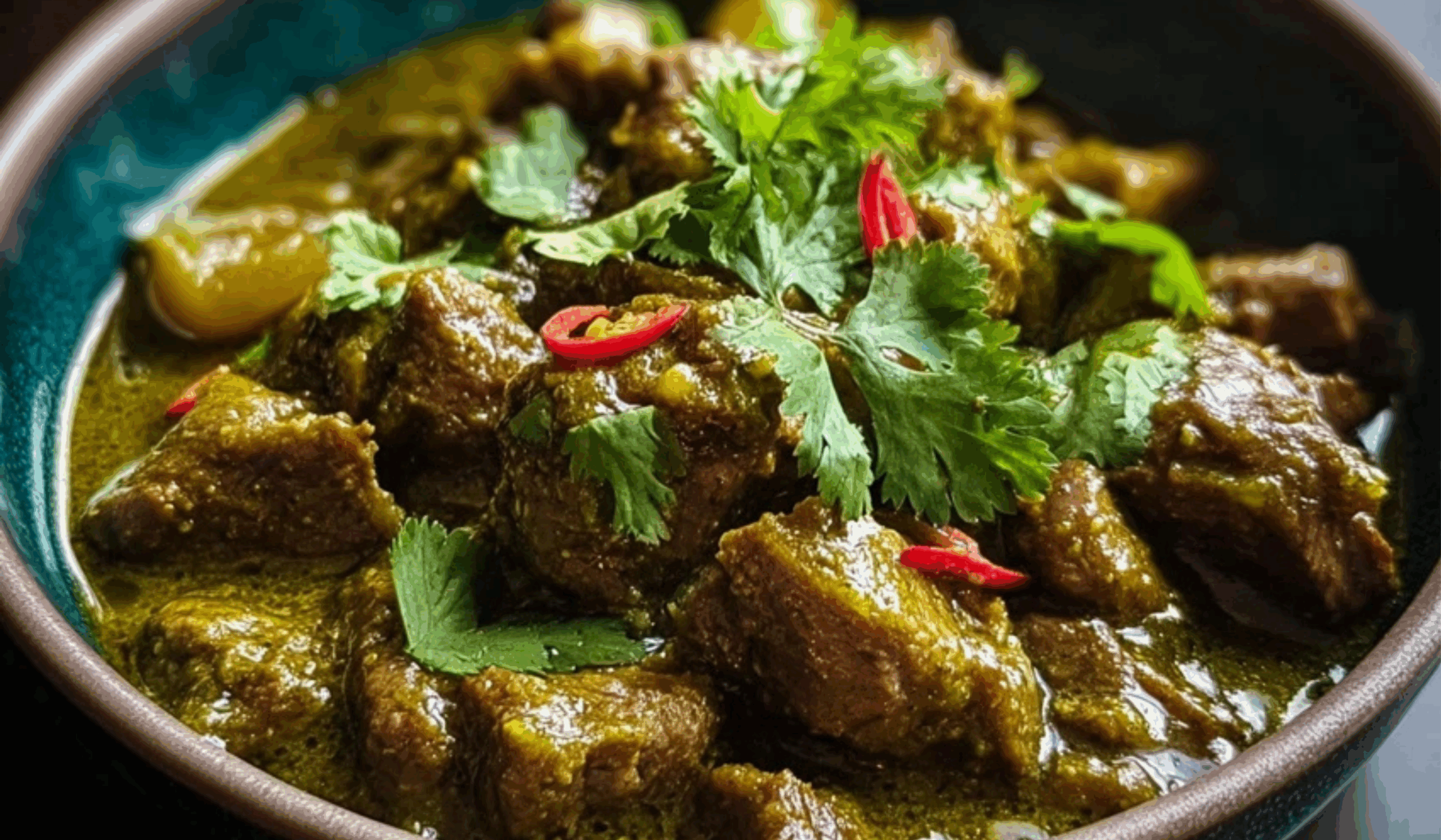Hearty Mexican Beef Chile Verde: A Comforting Classic for Every Kitchen
If you’re craving a meal that’s both robust in flavor and comforting in texture, look no further than Mexican Beef Chile Verde. This traditional dish is a warm, savory stew featuring tender chunks of beef slow-cooked in a bold green sauce made from tomatillos, green chilies, and aromatic spices. It’s a must-try for anyone who enjoys rich, soul-satisfying meals with a subtle kick of heat.

Chile Verde, which means “green chili” in Spanish, is typically made with pork in many regional versions across Mexico and the southwestern United States. However, in this recipe, we give it a delicious twist by using beef. The result? A deep, savory flavor that melds perfectly with the tangy and slightly spicy green sauce. The beef becomes irresistibly tender after simmering in the sauce for hours, soaking in all the vibrant flavors of the chiles and spices.
Ideal for family dinners, potlucks, or make-ahead meals, this dish is versatile and filling. Whether you serve it over rice, wrap it in warm tortillas, or simply enjoy it with a spoon, Mexican Beef Chile Verde will bring bold flavor to your table every time.
Ingredients and Preparation
Before diving into the cooking process, gather all your ingredients. Freshness is key here—especially for the tomatillos and green chilies, which form the foundation of the verde sauce.
For the Beef and Initial Browning:
- 2 pounds beef chuck roast or stew beef, cut into 1-inch cubes
- 1 tablespoon vegetable oil or olive oil
- Salt and pepper to taste
For the Chile Verde Sauce:
- 3 cups fresh tomatillos, husked and quartered
- 1 large white or yellow onion, chopped
- 5 cloves garlic, peeled
- 4 green chilies (such as Anaheim or poblano), seeded and chopped
- 1–2 jalapeños, seeded (optional, adjust for spice preference)
- 1 teaspoon ground cumin
- 1 teaspoon dried oregano
- 1 cup fresh cilantro leaves (plus more for garnish)
- 1 tablespoon lime juice (freshly squeezed)
- 1 ½ cups chicken or beef broth (low sodium)
Optional Garnishes and Add-ons:
- Chopped cilantro
- Diced avocado
- Lime wedges
- Sour cream or plain Greek yogurt
- Cooked white or Mexican rice
- Warm flour or corn tortillas
Step-by-Step Instructions
Follow these detailed steps to create a delicious pot of Mexican Beef Chile Verde from scratch:
- Prepare the Beef:
- Season the cubed beef with salt and pepper.
- In a large Dutch oven or heavy-bottomed pot, heat 1 tablespoon of oil over medium-high heat.
- Add the beef in batches to avoid overcrowding the pan. Sear on all sides until browned. Remove the beef and set aside.
- Roast the Vegetables:
- Preheat your broiler. On a baking sheet, arrange the tomatillos (cut side down), chilies, onion, and garlic cloves.
- Broil for 7–10 minutes, or until the vegetables are charred and softened. Watch closely to avoid burning.
- Blend the Sauce:
- Transfer the roasted vegetables to a blender or food processor.
- Add cumin, oregano, cilantro, and lime juice. Blend until smooth.
- If the sauce is too thick, add a few tablespoons of broth to help it blend smoothly.
- Cook the Sauce:
- In the same pot where you browned the beef, pour in the verde sauce.
- Simmer for 5–10 minutes over medium heat to allow the flavors to meld.
- Add the browned beef back into the pot.
- Simmer Everything Together:
- Pour in the broth and stir well to combine.
- Bring to a low boil, then reduce the heat to low.
- Cover and simmer for 2 to 2 ½ hours, or until the beef is fork-tender and the sauce is rich and thickened.
- Final Adjustments:
- Taste and adjust seasoning if needed—more salt, lime juice, or even an extra pinch of cumin or oregano.
- If desired, use a spoon to skim off excess fat from the top before serving.
Beginner Tips and Notes
Making a stew-style dish like Chile Verde can seem intimidating, but with a few tips, even beginners will find success:
- Choose the right cut of beef: Chuck roast works best because it becomes tender after slow cooking. Avoid lean cuts—they may dry out.
- Use fresh tomatillos: They provide the tangy base of the sauce. If fresh tomatillos aren’t available, canned can be used in a pinch, but fresh is preferred.
- Broiling the vegetables adds depth: Don’t skip this step. It caramelizes the ingredients and gives the sauce a rich, smoky note.
- Adjust spice to your liking: Jalapeños and poblanos vary in heat. Remove seeds for less spice, or leave some in if you want a kick.
- Make it ahead: Like many stews, this dish gets even better the next day. Store it in the fridge for up to 4 days, or freeze for up to 3 months.
- Thicken if needed: If the sauce is too thin at the end, remove the lid and simmer uncovered for 10–15 minutes.
- Blend sauce carefully: If using a blender, allow the roasted vegetables to cool slightly first, and blend in batches to avoid splatter.
Hearty Mexican Beef Chile Verde: A Comforting Classic for Every Kitchen
Cozy up with this Hearty Mexican Beef Chile Verde, a bold and comforting dish that never disappoints! 🥩🌶️ Tender chunks of beef simmer in a rich green sauce made from tomatillos, roasted chiles, garlic, and spices. 🧄🍃 Perfect with rice, tortillas, or beans, it’s a soul-warming favorite packed with zesty flavor. Whether for Sunday dinner or weeknight comfort, this classic brings authentic taste and home-cooked love to your kitchen! 🍽️💚
- Prep Time: 25 minutes
- Cook Time: 2 hours 30 minutes
- Total Time: 2 hours 55 minutes
- Yield: 6 servings 1x
Ingredients
For the Beef and Initial Browning:
-
2 pounds beef chuck roast or stew beef, cut into 1-inch cubes
-
1 tablespoon vegetable oil or olive oil
-
Salt and pepper to taste
For the Chile Verde Sauce:
-
3 cups fresh tomatillos, husked and quartered
-
1 large white or yellow onion, chopped
-
5 cloves garlic, peeled
-
4 green chilies (such as Anaheim or poblano), seeded and chopped
-
1–2 jalapeños, seeded (optional, adjust for spice preference)
-
1 teaspoon ground cumin
-
1 teaspoon dried oregano
-
1 cup fresh cilantro leaves (plus more for garnish)
-
1 tablespoon lime juice (freshly squeezed)
-
1 ½ cups chicken or beef broth (low sodium)
Optional Garnishes and Add-ons:
-
Chopped cilantro
-
Diced avocado
-
Lime wedges
-
Sour cream or plain Greek yogurt
-
Cooked white or Mexican rice
-
Warm flour or corn tortillas
Instructions
-
Prepare the Beef:
-
Season the cubed beef with salt and pepper.
-
In a large Dutch oven or heavy-bottomed pot, heat 1 tablespoon of oil over medium-high heat.
-
Add the beef in batches to avoid overcrowding the pan. Sear on all sides until browned. Remove the beef and set aside.
-
-
Roast the Vegetables:
-
Preheat your broiler. On a baking sheet, arrange the tomatillos (cut side down), chilies, onion, and garlic cloves.
-
Broil for 7–10 minutes, or until the vegetables are charred and softened. Watch closely to avoid burning.
-
-
Blend the Sauce:
-
Transfer the roasted vegetables to a blender or food processor.
-
Add cumin, oregano, cilantro, and lime juice. Blend until smooth.
-
If the sauce is too thick, add a few tablespoons of broth to help it blend smoothly.
-
-
Cook the Sauce:
-
In the same pot where you browned the beef, pour in the verde sauce.
-
Simmer for 5–10 minutes over medium heat to allow the flavors to meld.
-
Add the browned beef back into the pot.
-
-
Simmer Everything Together:
-
Pour in the broth and stir well to combine.
-
Bring to a low boil, then reduce the heat to low.
-
Cover and simmer for 2 to 2 ½ hours, or until the beef is fork-tender and the sauce is rich and thickened.
-
-
Final Adjustments:
-
Taste and adjust seasoning if needed—more salt, lime juice, or even an extra pinch of cumin or oregano.
-
If desired, use a spoon to skim off excess fat from the top before serving.
-
Notes
- Choose the right cut of beef: Chuck roast works best because it becomes tender after slow cooking. Avoid lean cuts—they may dry out.
- Use fresh tomatillos: They provide the tangy base of the sauce. If fresh tomatillos aren’t available, canned can be used in a pinch, but fresh is preferred.
- Broiling the vegetables adds depth: Don’t skip this step. It caramelizes the ingredients and gives the sauce a rich, smoky note.
- Adjust spice to your liking: Jalapeños and poblanos vary in heat. Remove seeds for less spice, or leave some in if you want a kick.
- Make it ahead: Like many stews, this dish gets even better the next day. Store it in the fridge for up to 4 days, or freeze for up to 3 months.
- Thicken if needed: If the sauce is too thin at the end, remove the lid and simmer uncovered for 10–15 minutes.
- Blend sauce carefully: If using a blender, allow the roasted vegetables to cool slightly first, and blend in batches to avoid splatter.
Serving Suggestions
One of the best parts of Mexican Beef Chile Verde is its flexibility. You can serve it in several delicious ways depending on your preference or the occasion:
- Over white or Mexican rice: A classic way to soak up the flavorful sauce.
- In warm tortillas: Makes for excellent tacos or burritos, especially when topped with avocado and sour cream.
- With beans and rice: Pair with refried beans or black beans for a traditional plate.
- As a stew: Simply enjoy it in a bowl with a side of warm bread or tortillas.
- As nacho topping: Spoon over tortilla chips and top with melted cheese for a hearty snack or appetizer.
- With eggs for breakfast: Heat leftovers and top with a fried egg and fresh cilantro for a savory breakfast or brunch.
Final Thought
Mexican Beef Chile Verde is a wonderful way to experience authentic flavors in a comforting and satisfying format. It brings together the rich depth of slow-cooked beef with the bright, zesty vibrance of tomatillos and green chilies. Whether you’re cooking for a family dinner, a gathering with friends, or meal prepping for the week, this dish won’t disappoint.
Its beauty lies in its simplicity—basic ingredients transformed through slow cooking and careful layering of flavors. It’s also an excellent example of how traditional recipes can be adapted to different dietary preferences without sacrificing taste or quality. By swapping pork for beef, we keep all the beloved richness of Chile Verde while offering a delicious alternative for those avoiding pork.








